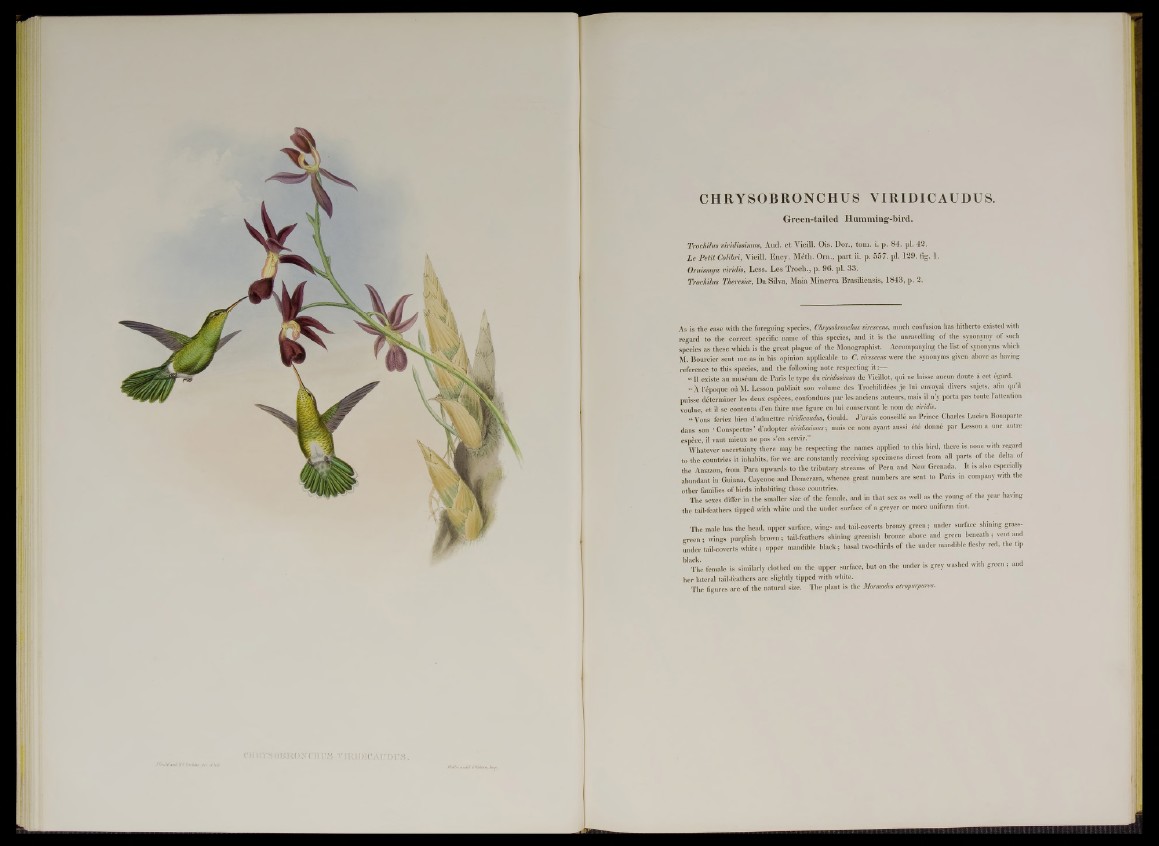
CHRYSOBRONCHUS VIRIDICAUDUS.
Green-tailed Humming-bird.
Trochilm mridiaaimus, Aud. e t Vieill. Ois. Dor., tom. i. p. 84. pi. 42.
L e Petit Colibri, Vieill. Ency. Meth. Om., p a rt ii. p. 557. pi. 129. fig. 1.
Omismya viridis, Less. Le s Troch., p . 96. p i. 33.
Trochilm Theresite, Da Silva, Maia M inerva Brasiliensis, 1843, p. 2.
As is the case with the foregoing species, Chrysohronchus mrescem, much confusion has hitherto existed with
regard to the correct specific name of this species, and it is the unravelling of the synonymy of such
species as these which is the great plague of the Monographist. Accompanying the list of synonyms which
M. Bourcier sent me as in his opinion applicable to C. mescem were the synonyms given above as having
reference to this species, and the following note respecting it
“ Il existe au muséum de Paris le type du mridissimus de Vieillot, qui ne laisse aucun doute à cet égard.
“ À l’époque où M. Lesson publiait son volume des Trochilidées je lui envoyai divers sujets, afin qu’il
puisse déterminer les deux espèces, confondues par les anciens auteurs, mais il n’y porta pas toute l'attention
voulue, et il se contenta d’en faire nue figure en lui conservant le nom de midis.
“ Vous feriez bien d’admettre oiridicaudus, Gould. J ’avais conseillé au Prince Charles Lucien Bonaparte
dans son • Conspectus ’ d’adopter mridissimus ; mais ce nom ayant aussi été donné par Lesson a une autre
espèce, il vaut mieux ne pas s’en servir.”
Whatever uncertainty there may be respecting the names applied to this bird, there is none with regard
to the countries it inhabits, for we are constantly receiving specimens direct from all parts of the delta of
the Amazon, from Para upwards to the tributary streams of Peru and New Grenada. It is also especially
abundant in Guiana, Cayenne and Demerara, whence great numbers are sent to Pans in company with the
other families of birds inhabiting those countries.
The sexes differ in the smaller size of the female, and iu that sex as well as the young of the year having
the tail-feathers tipped with white and the under surface of a greyer or more uniform tint.
The male has the head, upper surface, wing- and tail-coverts bronzy green ; under surface shining grass-
green ■ wings purplish brown ; tail-feathers shining greenish bronze above and green beneath ¡ vent and
u n d e r tail-coverts white; upper mandible black; basal two-thirds of the under mandible fleshy red, the tip
The female is similarly clothed on the upper surface, but on the under is grey washed with green ; and
her lateral tail-feathers are slightly tipped with white.
The figures are of the natural size. The plant is the Mormodes atropurpúrea.